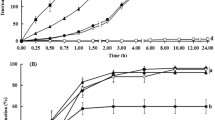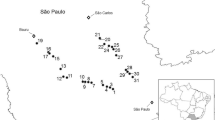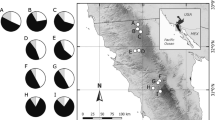Abstract
Seed predation by insects exerts negative effects on plant reproduction by limiting the supply of seeds and preventing germination. Seed predators of the family Fabaceae are usually generalists, which increases the rate of predation. One strategy to minimize seed predation, developed by plants from temperate regions, is “escape in time,” i.e., flowering before or after the peak of predation. For tropical species, few studies have investigated the strategies used by plants to minimize seed predation. Here, using Erythrina falcata, a tropical species of Fabaceae, we test three main hypotheses: (i) escape in time is a mechanism used by E. falcata to minimize seed predation, (ii) the predators of E. falcata seeds are generalists, and (iii) the biometric variables of the pods can influence seed predation. In order to test these hypotheses, we determined the flowering time of E. falcata, rate of seed predation, the predators insects, and biometric variables of the pods. The analyzed trees were grouped into three classes: “early,” “peak,” and “late” flowering. The average seed predation rates on trees in the early and late classes were 65% and 50%, respectively, and in the peak class, 80%; thus, our first hypothesis can be accepted. Three species of Lepidoptera and two of Coleoptera were found preying on E. falcata seeds. These species were observed to be generalist predators; thus, our second hypothesis can be accepted. The biometric variables of the pods cannot influence seed predation rate. The ecological consequences of asynchronous flowering on plants and insects are discussed.




Similar content being viewed by others
References
Allotey J, Morris JG (1993) Biology of Cathartus quadricollis (Guerin-Meneville) (Coleoptera: Silvanidae) on some selected food media. Insect Sci Applicatta 14:61–68
Augspurger CK (1981) Reproductive synchrony of a tropical shrub: experimental studies of effects of pollinators and seed predators in Hybanthus prunifolius (Violaceae). Ecology 62:775–788
Bates D, Maechler M, Bolker B (2012) Linear mixed-effects models using S4 classes. R package version 0.999999-0. http://CRAN.R-project.org/package=lme4. Accessed 15 Jan 2013
Begon M, Harper JL, Townsend CR (2007) Ecology: individuals, populations and communities. Blackwell Science, Oxford, 876 p
Bolker BM, Brooks ME, Clark CJ, Geange SW, Poulsen JR, Stevens MHH, White J-S S (2008) Generalized linear mixed models: a practical guide for ecology and evolution. Trends Ecol Evol 24:127–135
Carvalho PER (2003) Espécies arbóreas Brasileiras. Embrapa Florestas, Colombo, 1039 p
Casari SA, Teixeira EP (1997) Description and biological notes of final larval instar and pupa of some seed beetles (Coleoptera, Chrysomelidae, Bruchinae). Annales de La Societe Entomologique de France, Paris, França 33(3):295–321
Caviglione JH, Kiihl LRB, Caramori PH, Oliveira D (2000) Cartas climáticas do Paraná. IAPAR, CD, Londrina
Connell JH (1971) On the role of natural enemies in preventing competitive exclusion in some marine animals and in rain forest trees. Centre for Agricultural Publishing and Documentation, Wageningen, the Netherlands, pp 298–312
Costa RACV, Morais ABB (2008) Phenology and floral visitors of Erythrina crista-galli L. (Leguminosae: Faboideae) in Santa Maria, Rio Grande do Sul, Brazil. Biotemas 21:51–56
Elzinga JA, Atlan A, Biere A, Gigord L, Weis AE, Bernasconi G (2007) Time after time: flowering phenology and biotic interactions. Trends Ecol Evol 22:432–439
English-Loeb GM, Karban R (1992) Consequences of variation in flowering phenology for seed head herbivory and reproductive success in Erigeron glaucus (Compositae). Oecologia 89:588–595
Evans EW (1989) Timing of reproduction in a prairie legume: seasonal impacts of insects consuming flowers and seeds. Oecologia 78:220–230
Ferrer J, Odegaard F (2005) New species of darkling beetles from Central America with systematic notes (Coleoptera: Tenebrionidae). Ann Zool Warszawa 55(4):633–661
Ferro VG, Guimaraes Junior PR, Trigo JR (2006) Why do larvae of Utetheisa ornatrix penetrate and feed in pods of Crotalaria? Larval performance versus chemical and physical constraints. Entomol Exp Appl 121:23–29
Fox J (2003) Effect displays in R for generalised linear models. J Stat Softw 8 (15):1–27. URL: http://www.jstatsoft.org/v08/i15/. Accessed 17 Jan 2013
Freeman RS, Brody AK, Neefus CD (2003) Flowering phenology and compensation for herbivory in Ipomopsis aggregata. Oecologia 136:394–401
Fröborg H, Eriksson O (2003) Predispersal seed predation and population dynamics in the perennial understorey herb Actaea spicata. Can J Bot 81:1058–1069
Gomez JM (1993) Phenotypic selection on flowering synchrony in a high-mountain plant, Hormathophylla spinosa (Cruciferae). J Ecol 81:605–613
Haines CP (1991) Insects and arachnids of tropical stored products: their biology and identification. Natural Resources Institute, Chatham, 246 p
Janzen DH (1971) Escape of Cassia grandis L. beans from predators in time and space. Ecology 52:964–979
Janzen DH, Hallwachs W (2011) Area de Conservación Guanacaste (ACG), northwestern Costa Rica: caterpillars, pupae, butterflies & moths database. http://janzen.sas.upenn.edu/. Accessed 28 Sep 2011
Johnson CD (1981) Interactions between bruchid (Coleoptera) feeding guilds and behavioral patterns of fruits of the Leguminosae. Environ Entomol 10:249–253
Johnson CD, Romero J (2004) A review of evolution of oviposition guilds in the Bruchidae (Coleoptera). Rev Bras Entomol 48:404–408
Johnson CD, Zona S, Nilsson JA (1995) Bruchid beetles and palm seeds: recorded relationships. Principes 39:25–35
Köppen W, Geiger R (1928) Klimate der Erde. Verlag Justus Perthes, Gotha, Wall-map 150cmx200cm
Liebsch D, Mikich SB (2009) Fenologia reprodutiva de espécies vegetais da Floresta Ombrófila Mista do Paraná, Brasil. Rev Bras Bot 32:375–391
Lima AC (1950) Insetos do Brasil. Escola Nacional de Agronomia, Rio de Janeiro, Brasil, 420 p
Louda SM (1982) Distribution ecology: variation in plant recruitment over a gradient in relation to insect seed predation. Ecol Monogr 52:25–41
Maack R (1948) Notas preliminares sobre clima, solos e vegetação do Estado do Paraná. Braz Arch Biol Technol 2:102–200
Mahoro S (2002) Individual flowering schedule, fruit set, and flower and seed predation in Vaccinium hirtum Thunb. (Ericaceae). Can J Bot 80:82–92
Mazer S, Schick TC (1991) Constancy of population parameters for life-history and floral traits in Raphanus sativus L. Effects of plant density on phenotype and heritability estimates. Heredity 45:1888–1907
Munguía-Rosas MA, Ollerton J, Parra-Tabla V, De-Nova JA (2011) Meta-analysis of phenotypic selection on flowering phenology suggests that early flowering plants are favoured. Ecol Lett 14:511–521
O’Neil P (1997) Natural selection on genetically correlated phenological characters in Lythrum salicaria L (Lythraceae). Evolution 51:267–274
Picanço MC, Araújo JM, Faleiro FG, Miranda MMM (1994) Intensidade de Ataque de Cathartus quadricollis Guerin, 1829 (Coleoptera: Silvanidae) a 49 populações de milho de polinização aberta. Rev Bras Armaz 18:11–14
Poderoso JCM, Dantas PC, Passos EM, Ribeiro GT, Oliveira MEC (2008) Registro da Agathodes designalis (Guenée, 1854) (Lepidoptera: Pyralidae) em Mulungu (Erythrina velutina) (Willd.) no Viveiro de Mudas de Espécies Florestais Nativas no Município de São Cristóvão, Sergipe, Brasil. EntomoBrasilis 1:14–15
Powell JA, Opler PA (2009) Moths of Western North America. University of California Press, Berkeley, 369 p
R Development Core Team (2012) R: a language and environment for statistical computing. R Foundation for Statistical Computing, Vienna. ISBN 3-900051-07-0, URL http://www.R-project.org/. Accessed 18 Jan 2013
Ramírez N, Traveset A (2010) Predispersal seed-predation by insects in the Venezuelan Central Plain: overall patterns and traits that influence its biology and taxonomic groups. Perspect Plant Ecol Evol Syst 12:193–209
Raven PH (1974) Erythrina (Fabaceae): achievements and opportunities. Lloydia 37:321–331
Root RB (1973) Organization of a plant-arthropod association in simple and diverse habitats: the fauna of collards (Brassica oleracea). Ecol Monogr 43:95–119
Santos GP, Araújo FS, Fantuzzi Neto H, Monteiro AJA (1994) Danos em sementes de Cassia ferruginea causados por Zabrotes interstitialis, Pygiopachymerus lineola (Coleoptera: Bruchídae) e um Lepidoptera (PyraJidae). Rev Bras Biol 54:311–316
Sari LT, Ribeiro-Costa CS, Roper J (2005) Dinâmica populacional de Bruchinae (Coleoptera:Chrysomelidae) em Senna multijuga L.C. Richard I. e B. (Caesalpinaceae). Rev Bras Zool 22:169–174
Scherer KZ, Romanowski HP (2005) Predação de Megacerus baeri (Pic, 1934) (Coleoptera: Bruchidae) sobre sementes de Ipomoea imperati (Convolvulaceae), na praia da Joaquina, Florianópolis, sul do Brasil. Biotemas 18:39–55
Schupp EW (1992) Annual variation in seedfall, postdispersal predation, and recruitment of a neotropical tree. Ecology 71:504–515
Serrano JM, Delgado JA, Lòpez F, Acosta FJ, Fungairiño SG (2001) Multiple infestation by seed predators: the effect of loculate fruits on intraspecific insect larval competition. Acta Oecol 22:153–160
Silva TGM, Gonçalves CL, Júnior EMF, Domingues EBS, Silva LC, Pimenta M, Batista MTA, Nunes YRF (2004) Influência da predação, parasitismo e escarificação mecânica na germinação de sementes de Acacia bahiensis Benth. (Fabaceae-Mimosoideae). Anais do I Simpósio de Entomologia UFV: uma visão interdisciplinar. Viçosa, pp 281–284
Sourakov A (2011) Niche partitioning, co-evolution and life histories of Erythrina moths, Terastia meticulosalis and Agathodes designalis (Lepidoptera: Crambidae). Trop Lipid Res 21:84–94
StatSoft Inc. (2001) STATISTICA (data analysis software system), version 6. http://www.statsoft.com/. Accessed 12 Aug 2013
Steven D (1981) Predispersal seed predation in a tropical shrub (Mabea occidentials, Euphorbiaceae). Biotropica 13:146–150
USGS http://esp.cr.usgs.gov/data/atlas/little/erytherb.pdf. Accessed 5 May 2014
Visser MD, Jongejans E, Van Breugel M, Zuidema PA, Chen YY, Kassim AR, Kroon H (2011) Strict mast fruiting for a tropical dipterocarp tree: a demographic cost–benefit analysis of delayed reproduction and seed predation. J Ecol 99:1033–1044
Weis AE, Kossler TM (2004) Genetic variation in flowering time induces phenological assortative mating: quantitative genetic methods applied to Brassica rapa. Am J Bot 91:825–836
Zhang J, Drummond FA, Liebman N, Hatke A (1997) Insect predation of seeds and plant population dynamics. University of Maine, Bangor, USA, 32 p
Author information
Authors and Affiliations
Corresponding author
Additional information
Edited by Angelo Pallini – UFV
Rights and permissions
About this article
Cite this article
Pereira, C.M., Moura, M.O. & Da-Silva, P.R. Insect Seed Predators in Erythrina falcata (Fabaceae): Identification of Predatory Species and Ecological Consequences of Asynchronous Flowering. Neotrop Entomol 43, 193–200 (2014). https://doi.org/10.1007/s13744-014-0213-1
Received:
Accepted:
Published:
Issue Date:
DOI: https://doi.org/10.1007/s13744-014-0213-1




